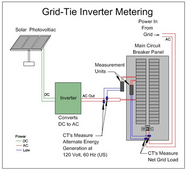I am new to Solar, but have been watching a lot of YouTube guides, including of our host, and reading online too.
I am seeing this system pop up on Amazon in Europe
I am new to these on-grid-only systems, but from reading it seems that the AC out goes into the house's AC out (!)
That got me worried that having 2 ACs plugged into each other is a recipe for

However, it seems that this is working by the on-grid inverter latching onto the sine wave of the house's electricity and basically working in tandem
That got me thinking : could you not use a portable power station, plug a solid AC power splitter into it, then the on-grid inverter AC out to the first socket on the AC splitter and then the load (e.g. fridge) to the second socket on the AC splitter?
: could you not use a portable power station, plug a solid AC power splitter into it, then the on-grid inverter AC out to the first socket on the AC splitter and then the load (e.g. fridge) to the second socket on the AC splitter?
Or will it
 and if so, why?
and if so, why?
Thanks I'm advance.
I am seeing this system pop up on Amazon in Europe
I am new to these on-grid-only systems, but from reading it seems that the AC out goes into the house's AC out (!)
That got me worried that having 2 ACs plugged into each other is a recipe for
However, it seems that this is working by the on-grid inverter latching onto the sine wave of the house's electricity and basically working in tandem
That got me thinking
Or will it
Thanks I'm advance.




